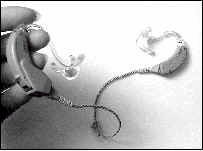Thursday, August 03, 2006
Cros/Bicros Aids
these aids are usually used if the patient has unilateral or asymmetric hearing loss. we don't fit much of these pero lately, it's getting more frequent. hmmn..what could have caused their unilateral/asymmetric losses - acoustic neuroma? middle ear problems? noise induced (like shooting on one side, gunfire)? trauma? vascular? the list goes on...
usually, hearing goes down at the same time on both ears. but if that is not the case, at least there's still another option. it might not be the best solution but at least, these may help.... it's not easy fitting these, u know? well, it's easy fitting them, technically. but getting the patients to wear a cord round the back of their head, getting them used to the idea that they have a microphone on one ear that will transmit sound to the other is a bit too much to take in. lalo na kung vain sila!


what you need: hearing aid, shoe, satellite microphone (looks like an aid) and cord.
anyways, these should explain more:
CROS/BiCROS hearing aids as defined by RNID.
(CROS - contralateral routing of signal)
These are for people with hearing in one ear only. CROS hearing aids pick up sound from the side with no hearing and feed it to the ear with normal or near normal hearing. BiCROS aids are similar but made for people with no useful hearing in one ear and some hearing loss in the other, so they make the sounds louder as well.
CROS/BiCROS as defined by NDCS
People with a profound unilateral deafness may benefit from a special type of hearing aid known as a CROS aid. Although it is described as a hearing aid, a CROS aid does not amplify sound. It simply transfers sound from the ear with deafness to the ear with hearing. The main advantage of using a CROS aid is that it can help the person to hear sounds from all directions.A CROS aid includes two units which both look like ordinary behind the ear hearing aids. However, the unit worn on the ear with deafness just contains a microphone. It is connected to the other unit, sometimes using a lead and sometimes using a wireless radio link. The patient listens to the sounds picked up by the microphone through the second unit, which they wear on their ear with hearing.BiCROS aids are used when there is no useful hearing in one ear and the other has some deafness. Sounds from a microphone on the side where there is no useful hearing are fed into the aid which amplifies sound for the better ear.





